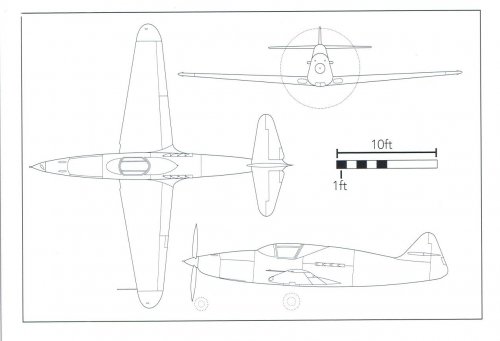You are using an out of date browser. It may not display this or other websites correctly.
You should upgrade or use an alternative browser.
You should upgrade or use an alternative browser.
Tucker Aviation XP-57
- Thread starter Justo Miranda
- Start date
Bailey
ACCESS: Secret
- Joined
- 24 July 2009
- Messages
- 308
- Reaction score
- 43
archipeppe
ACCESS: Top Secret
- Joined
- 18 October 2007
- Messages
- 2,431
- Reaction score
- 3,152
Is the same Tucker of the famous automobile?
Bailey
ACCESS: Secret
- Joined
- 24 July 2009
- Messages
- 308
- Reaction score
- 43
- Joined
- 25 June 2009
- Messages
- 14,754
- Reaction score
- 6,155
In case you never watched Francis Ford Coppola's movie "Tucker", with Jeff Bridges playing the main part, it is absolute must seeing. The soundtrack by Joe Jackson is also excellent, the cameo by Howard Hughes and his H-4 Hercules is a pure moment of joy... And so are all the surviving Tucker cars (46 out of 50 built) that gather for the film's final scene...). Unfortunately there is no mention in the movie that Tucker ever designed an aircraft as such.
Almost forgot: that's the only movie directed by "Francis Coppola", with no "Ford" in between. The Ford company was largely responsible for Tucker's demise, though there is no actual mention of it in the movie. Coppola probably saw this as a subtle hint of that fact...
Almost forgot: that's the only movie directed by "Francis Coppola", with no "Ford" in between. The Ford company was largely responsible for Tucker's demise, though there is no actual mention of it in the movie. Coppola probably saw this as a subtle hint of that fact...
saturncanuck
Any landing you can walk away from, is a good one.
Stargazer2006 said:In case you never watched Francis Ford Coppola's movie "Tucker", with Jeff Bridges playing the main part, it is absolute must seeing. The soundtrack by Joe Jackson is also excellent, the cameo by Howard Hughes and his H-4 Hercules is a pure moment of joy... And so are all the surviving Tucker cars (46 out of 50 built) that gather for the film's final scene...). Unfortunately there is no mention in the movie that Tucker ever designed an aircraft as such.
Almost forgot: that's the only movie directed by "Francis Coppola", with no "Ford" in between. The Ford company was largely responsible for Tucker's demise, though there is no actual mention of it in the movie. Coppola probably saw this as a subtle hint of that fact...
Just for the record, there is no proof that any of the "Big Three" conspired against Tucker and his "Torpedo". After the war, steel was allocated to firms based on their war production -- and Tucker's turrets were certainly less than the amount of aircraft built by GM and Ford and the tanks by Chrysler. Besides, with millions of Americans demanding new cars post-WWII, it is highly unlikely that the "Big Three" perceived Tucker -- and his unmechanized assembly line -- as a threat.
Still, I agree that the movie has an amzing soundtrack, and it is wonderful to see all those Torpedos together on film. BTW, the crash sequences were performed with Torpedo-nose Studabakers.
royabulgaf
ACCESS: Top Secret
- Joined
- 29 December 2008
- Messages
- 678
- Reaction score
- 350
At best, Tucker was a visionary who had no idea how costly the automotive business is. In addition he wasted what little funds he had.
Alex Tremulis worked briefly as a consultant for Tucker Motors, essentially as a B team stylist to provide an alternate view to the in-house styling department. He wrote a book about it, and it is fascinating.
Alex Tremulis worked briefly as a consultant for Tucker Motors, essentially as a B team stylist to provide an alternate view to the in-house styling department. He wrote a book about it, and it is fascinating.
- Joined
- 8 March 2009
- Messages
- 1,057
- Reaction score
- 1,299
From NTRS;
[/size]
[/size]The Tucker XP-57, proposed in 1940, weighed 3000 pounds loaded. The engine was located behind the pilot with the propeller drive shaft passing between the pilot's legs. With a fully loaded wing loading of 25 psf, the airplane was expected to be highly maneuverable but it was never completed
http://ntrs.nasa.gov/archive/nasa/casi.ntrs.nasa.gov/19830018514_1983018514.pdf
[/size]
[/size]The Tucker XP-57, proposed in 1940, weighed 3000 pounds loaded. The engine was located behind the pilot with the propeller drive shaft passing between the pilot's legs. With a fully loaded wing loading of 25 psf, the airplane was expected to be highly maneuverable but it was never completed
http://ntrs.nasa.gov/archive/nasa/casi.ntrs.nasa.gov/19830018514_1983018514.pdf
- Joined
- 25 June 2009
- Messages
- 14,754
- Reaction score
- 6,155
I can only encourage anyone with an interest in either automotive history, great entrepreneurs, Francis Ford Coppola, Joe Jackson music, Howard Hughes or Jeff Bridges (not necessarily in that order) to watch the 1989 movie Tucker. Absolutely brilliant as far as I'm concerned (but don't look for any mention of the XP-57 in it, there's none!). As a footnote, this is the only movie where Coppola dropped the "Ford" in his name, being credited as plain "Francis Coppola". It is said that this was his own silent way of bashing the Ford company without ever mentioning it by name in the movie (Ford, among other misdeeds, made sure to that Tucker's projects failed).
We "know" very little about the Tucker Aircraft Company, as to the use of the AL-5 designation what's the originalHi,
we know this aircraft was called AL-5,what are the other 4 designs ?,we got only a four-seat
light airplane project.
source? Even if it was designated AL-5 it doesn't mean it was preceded by four other designs, indeed it would be
just like Preston Tucker to use a number that made it look like the company had experience with aircraft design.
The guy was an inveterate BS artist.
As to the XP-57 definitive information is also lacking and the 3-views are very suspect, especially as every one out there is either a direct copy or a redraw of Lloyd S. Jones drawing from his U.S. Fighters which was first published in 1975. Who knows what his source was, the drawing also has the problem that it only shows four exhaust stacks on the sideview of the port side, the plan view drawing is in his typical style with the top and bottom both shown in the view this also shows four exhausts, the front view indicates stacks on both sides which has led folks to redraw the Jones drawing into what you see in the drawing that started this topic. The plan view in the Norton drawing shows four exhausts each side in a typical V-8 engine setup, yet his text claims a V-12. The L-510 is an inline 8 cylinder engine made up of two 4 cylinder engines mounted inline, which means that it's going to have all of the exhaust stacks on one side of the fuselage and the induction system on the other.
I think it would depend on how the two engines were combined. If the two four-cylinder units were mounted nose-to-nose on a common gearbox, there might conceivably be four exhaust stacks on each side.The L-510 is an inline 8 cylinder engine made up of two 4 cylinder engines mounted inline, which means that it's going to have all of the exhaust stacks on one side of the fuselage and the induction system on the other.
- Joined
- 25 July 2007
- Messages
- 4,299
- Reaction score
- 4,198
... and we also must note the company produced a motors ?.
What does this refer to?
jcf was discussing Harry Miller's L-510 engine for Tucker. AFAIK, Preston Tucker relied exclusively on Miller and his team for engine designs (or adaptations). Of course, later on, Tucker bought out Air-Cooled Motor Corporation to gain access to the Franklin 6A ... but that was for automotive use.
Were there other aero-engine designs distinct to Tucker Aviation or the Tucker Corporation?
- Joined
- 26 May 2006
- Messages
- 34,917
- Reaction score
- 15,790
What does this refer to?
jcf was discussing Harry Miller's L-510 engine for Tucker. AFAIK, Preston Tucker relied exclusively on Miller and his team for engine designs (or adaptations). Of course, later on, Tucker bought out Air-Cooled Motor Corporation to gain access to the Franklin 6A ... but that was for automotive use.
Were there other aero-engine designs distinct to Tucker Aviation or the Tucker Corporation?
I think that,I saw on Net something like that.
Yes, the AL-5 designation has been repeated in several books, but what's the original source?My dear Jcf,
the source is the book of Tony Buttler,ASP1,and we also must note the company produced a motors ?.
Tucker didn't actually produce any engines, he just repeatedly tried to get the services to pay to turn
some of Harry Miller's concepts into hardware. Most of the designs pre-dated Tucker Aviation and
were recycled by Tucker. Harry's horsepower numbers were rather optimistic, to say the least.
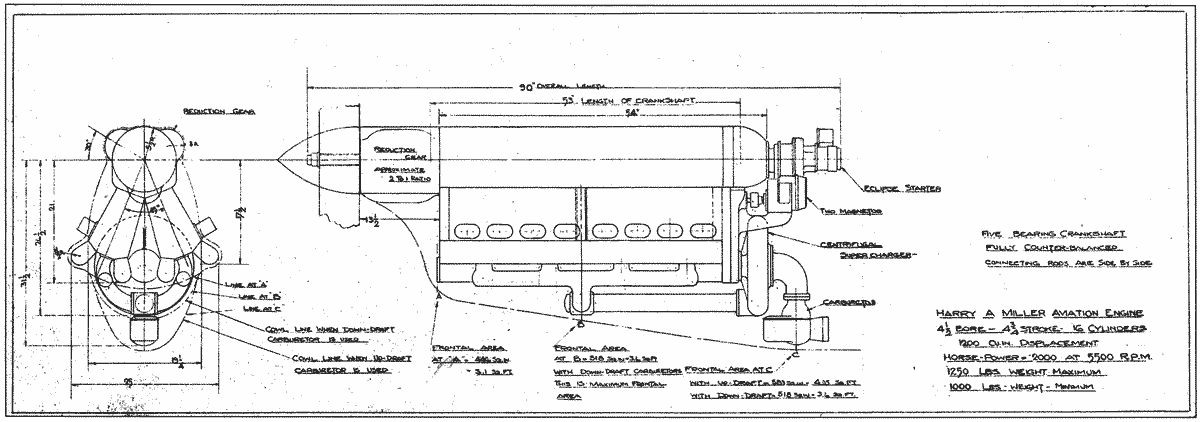
Inverted V-16, 1200 cu.in, 2,000hp.
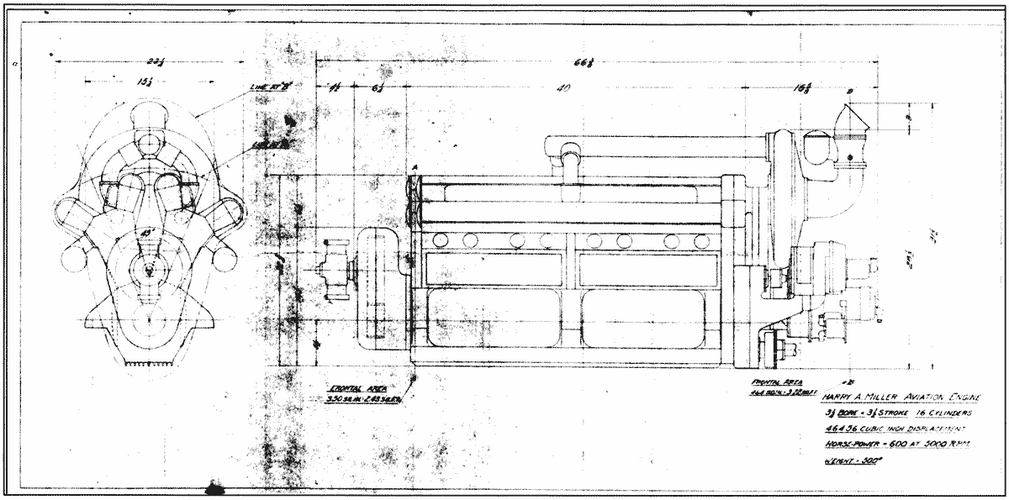
V-16, 464.5 cu.in., 600 hp.
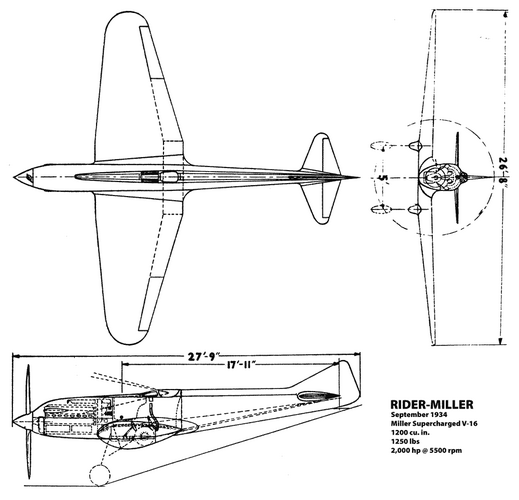
V-16 for Keith Rider.
Yep, I've played with various layouts including that one, but according to Mark Dees the crankshafts of the twoI think it would depend on how the two engines were combined. If the two four-cylinder units were mounted nose-to-nose on a common gearbox, there might conceivably be four exhaust stacks on each side.
engines were connected together. The biggest problem the opposite handed notion is that the rear engine will
have its intake downstream of the exhaust of the other engine. That would make cooling the compressed
fuel and air mix more complicated.
Air Classics magazine for March 2019 produces a 13 page long article
written by Marshall Wainwright. about Tucker and his exploits..
The man was not an aeronautical engineer , but a salesman who did a
lot of selfpromting according the article.
It seems that the XP-57 was his only try to put an aircraft design on paper (and in production)
Tucker type number shoud be AL-2 .This left the question if there was an AL-1
so far the text.
Besides his light weight fighter, he was also involved in the construction of Indi race cars, an armoured combat car
a gun turret and a small series of limousines.
According to the author, no original drawing of the Tucker fighter was found.
written by Marshall Wainwright. about Tucker and his exploits..
The man was not an aeronautical engineer , but a salesman who did a
lot of selfpromting according the article.
It seems that the XP-57 was his only try to put an aircraft design on paper (and in production)
Tucker type number shoud be AL-2 .This left the question if there was an AL-1
so far the text.
Besides his light weight fighter, he was also involved in the construction of Indi race cars, an armoured combat car
a gun turret and a small series of limousines.
According to the author, no original drawing of the Tucker fighter was found.
Last edited:
- Joined
- 11 March 2012
- Messages
- 3,251
- Reaction score
- 3,179
2,000 horsepower from only 1,200 cubic inches sounds optimistic. You might be able to supercharge a race engine to that level for a few minutes, but I doubt if the engine would last very long.Yes, the AL-5 designation has been repeated in several books, but what's the original source?
Tucker didn't actually produce any engines, he just repeatedly tried to get the services to pay to turn
some of Harry Miller's concepts into hardware. Most of the designs pre-dated Tucker Aviation and
were recycled by Tucker. Harry's horsepower numbers were rather optimistic, to say the least.View attachment 707320
Inverted V-16, 1200 cu.in, 2,000hp.
View attachment 707321
V-16, 464.5 cu.in., 600 hp.
View attachment 707322
V-16 for Keith Rider.
Secondly, that 3-view drawing is obviously for a specialized race plane. 1930s race planes were notoriously difficult to control at slow air speeds with their small control surfaces and poor visibility from the cockpit.
Last edited:
- Joined
- 25 July 2007
- Messages
- 4,299
- Reaction score
- 4,198
... Secondly, that 3-view drawing is obviously for a specialized race plane...
Rider Super Speed Racer concept.
-- https://www.secretprojects.co.uk/threads/keith-rider-racing-aircraft-designs.13861/
Scott Kenny
ACCESS: USAP
- Joined
- 15 May 2023
- Messages
- 11,663
- Reaction score
- 14,373
That's screamingly optimistic for engines then. Most aircraft engines were still working towards one hp per cubic inch, even the mighty Merlin was 1500hp out of 1650cubic inches.Inverted V-16, 1200 cu.in, 2,000hp.
(image deleted for space)
V-16, 464.5 cu.in., 600 hp.
Yes, I know thus why I stated it was for Keith Rider.2,000 horsepower from only 1,200 cubic inches sounds optimistic. You might be able to supercharge a race engine to that level for a few minut s, but I doubt if the engine would last very long.
Secondly, that 3-view drawing is obviously for a specialized race plane. 1930s race planes were notoriously difficult to control at slow air speeds with their small control surfaces and poor visibility from the cockpit.
Very optimistic numbers apparently based on the idea that as they achieved up to 250hp, at 8,000rpm, with the supercharged 91 cu.in. Miller 91 I-8 engine and that the two supercharged 1,113 cu.in. V-16s that Miller and Leo Goosen designed for Gar Wood in 1931 achieved 1,325hp at 4,000rpm and 1,800 at 6,000rpm. But, in the case of the Wood engines this was with massive Schweizer-Cummins Roots-type superchargers and the engines were never fully reliable. The engines were sold on by Wood and operated in naturally aspirated form, making 930hp at 4,500 rpm. Both engines survived and have been restored and installed in the restored Gar Wood Miss America VIII. The angle between the cylinder banks is 54º. BTW design of the engine started at the end of May - early June 1931 and the first engine run was on 25 August 1931.That's screamingly optimistic for engines then. Most aircraft engines were still working towards one hp per cubic inch, even the mighty Merlin was 1500hp out of 1650cubic inches.
In some ways the numbers for the 464.5 cu.in. and 1,200 cu.in. V-16s are conservative.
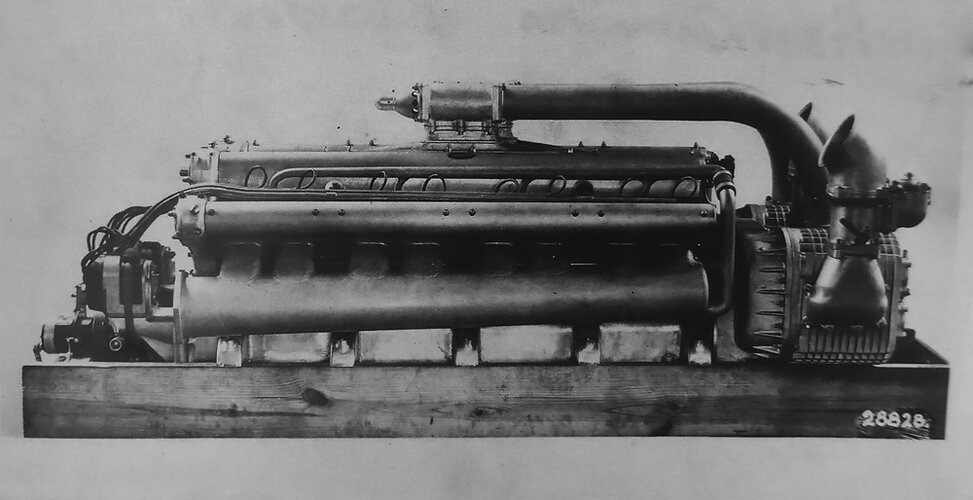
As run by Wood.
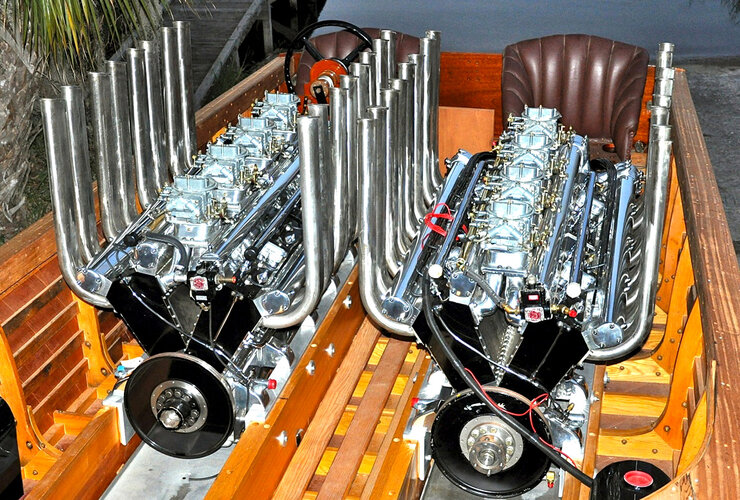
Naturally aspirated as installed in the restored Miss America VIII.
Scott Kenny
ACCESS: USAP
- Joined
- 15 May 2023
- Messages
- 11,663
- Reaction score
- 14,373
Might be achievable if they spun that fast, I was not expecting 4500+rpm out of a large displacement aircraft engine and then reduced to ~2000rpm at the prop.Very optimistic numbers apparently based on the idea that as they achieved up to 250hp, at 8,000rpm, with the supercharged 91 cu.in. Miller 91 I-8 engine and that the two supercharged 1,113 cu.in. V-16s that Miller and Leo Goosen designed for Gar Wood in 1931 achieved 1,325hp at 4,000rpm and 1,800 at 6,000rpm. But, in the case of the Wood engines this was with massive Schweizer-Cummins Roots-type superchargers and the engines were never fully reliable. The engines were sold on by Wood and operated in naturally aspirated form, making 930hp at 4,500 rpm. Both engines survived and have been restored and installed in the restored Gar Wood Miss America VIII. The angle between the cylinder banks is 54º. BTW design of the engine started at the end of May - early June 1931 and the first engine run was on 25 August 1931.
In some ways the numbers for the 464.5 cu.in. and 1,200 cu.in. V-16s are conservative.

He was involved in the Miller-Ford Indy cars, he convinced Edsel Ford to fund them, and promised in earlyAir Classics magazine for March 2019 produces a 13 page long article
written by Marshall Wainwright. about Tucker and his exploits..
The man was not an aeronautical engineer , but a salesman who did a
lot of selfpromting according the article.
It seems that the XP-57 was his only try to put an aircraft design on paper (and in production)
Tucker type number shoud be AL-2 .This left the question if there was an AL-1
so far the text.
Besides his light weight fighter, he was also involved in the construction of Indi race cars, an armoured combat car
a gun turret and a small series of limousines.
According to the author, no original drawing of the Tucker fighter was found.
1935 that ten cars would be ready for the Indy 500 on 31 May 1935. This was a front-wheel drive design
powered by the Ford flathead V-8. Due to typical Tucker overpromising and dithering they weren't actually
able to get started until March of 1935. Needless to say they didn't have the time to do proper testing and
it was found that the steering boxes were mounted too close to the exhaust manifold causing them to overheat
and fail. Tucker's name was mud with Henry Ford but Ford never held the failure of the program against
Harry. The cars were beautiful and very advanced on several levels.
Tucker's promotional BS for his car puffed up his connections to Miller's pre-war race cars, going from the
fact of his involvement with the Ford project to the stretch that he was involved with all of Harry's successful
engines of the '20s and '30s which had won 12 out of 16 Indy 500s between 1922 and 1938. This was BS.
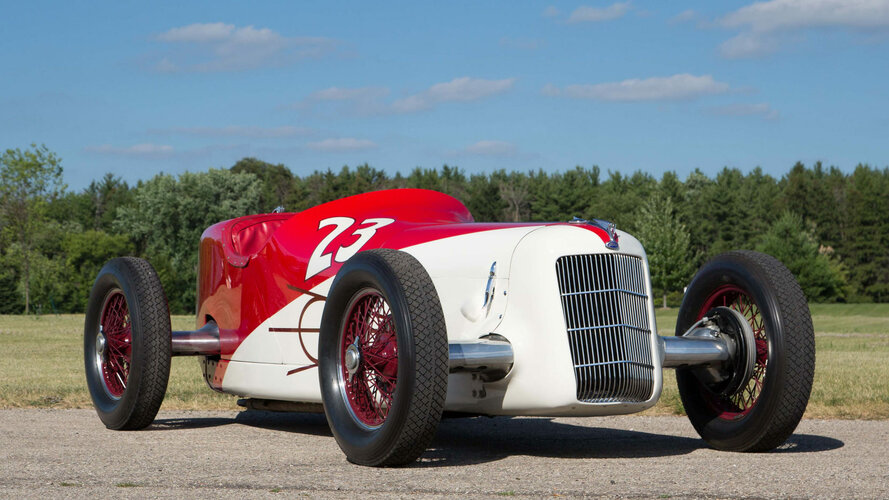
1935 Miller-Ford.
The drive ratio of the 7" centrifugal supercharger of the Miller 91 was 5.35:1, 42,800rpm at 8,000rpm, so yeah he liked things to be spinning fast.Might be achievable if they spun that fast, I was not expecting 4500+rpm out of a large displacement aircraft engine and then reduced to ~2000rpm at the prop.
Nope, there's simply not enough known and the design appears to have followed the XP-57.Can we assume that,the AL-1 was the four-place airplane ?.
It would be a matter of conjecture rather than assumption.
Trying to fit everything from any given company, especially small ones, into an exact sequence
is a questionable pursuit. Especially as it's not uncommon for earlier concepts/designs to be
retroactively assigned a number, which can be arbitrary and not necessarily chronological.
- Joined
- 26 May 2006
- Messages
- 34,917
- Reaction score
- 15,790
Nope, there's simply not enough known and the design appears to have followed the XP-57.
It would be a matter of conjecture rather than assumption.
Trying to fit everything from any given company, especially small ones, into an exact sequence
is a questionable pursuit. Especially as it's not uncommon for earlier concepts/designs to be
retroactively assigned a number, which can be arbitrary and not necessarily chronological.
But the XP-57 was studied in 5/1940 and up to 1941,and the Four-Place design was clearly the basis for it,why not ?.
- Joined
- 25 July 2007
- Messages
- 4,299
- Reaction score
- 4,198
But the XP-57 was studied in 5/1940 and up to 1941,and the Four-Place design was clearly the basis for it,why not ?.
You've got the basis for design backwards. In your clipping, the sentence beginning "The company is also building a fast military pursuit ..." is more of Preston Tucker's truth-bending but it does reveal the genealogy of the XP-57 and this 'Four-Place'. The former obviously predates the latter.
Note that your 5/1940 date is not necessarily for the design of the XP-57, rather, it was the charter date for the Tucker Aircraft Corporation. According to a Congressional report - Investigation of the National Defense Program - Part 38 - Tucker Aircraft was incorporated "for developing Power-operated aircraft turrets, fire interrupters, and gun stabilizers.This company became dormant in 1941, when the U. S. Government confiscated its patents." Note that there is no mention at all of aircraft design.
Similar threads
-
Tucker Four-Place Light Aircraft Project
- Started by hesham
- Replies: 9
-
-
-
-
Boeing XP-9 monoplane fighter prototype (Model 96)
- Started by Triton
- Replies: 2

